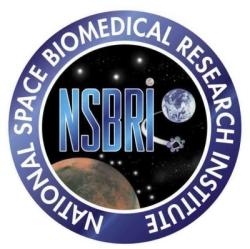Wed, Aug 21, 2013
Soliciting For A Center For Space Radiation Research
The National Space Biomedical Research Institute (NSBRI) is soliciting for program proposals to establish a Center for Space Radiation Research (CSRR). The CSRR will build upon important discoveries made by the NSBRI Center of Acute Radiation Research and extend them by characterizing and quantifying the effects of space radiation on living systems. Operating in close partnership with NASA's Human Research Program, the CSRR will be tasked with researching the acute effects of space radiation, as well as the longer term, so-called "degenerative" effects of space radiation on the cardiovascular and circulatory systems. Accordingly, the CSRR will work to reduce the radiation related health risks that will be encountered by astronaut crews during future missions to an asteroid, the Moon or Mars. This research announcement entitled "Center for Space Radiation Research" was released by NSBRI on August 14, 2013.

The CSRR will combine exposures to both solar and galactic particles, thereby more closely mimicking the environment actually experienced by astronauts during exploration missions. Pharmaceutical countermeasures will also be evaluated for their ability to mitigate the harmful effects of space radiation. Scientific discoveries made by the CSRR will not only enable safe and productive human exploration of space, but may also have the potential to improve life on Earth.
The CSRR will use a systems biology approach to characterize the effects of space radiation by combining physiological observations with new 21st century integrated -omics techniques, such as genomics, proteomics and metabolomics. This strategy will facilitate the correlation of observed health effects with the more fundamental underlying genetic and bimolecular changes that occur in response to radiation, thereby advancing knowledge and providing possible new options for the development and deployment of radiological countermeasures.
This NSBRI request for applications, (RFA) may be viewed online under the Funding Opportunities menu, within the Current Announcements section. The RFA is also available via the NASA Research Opportunities homepage by navigating through the menu listings "Solicitations" to "Open Solicitations." On the Open Solicitations page, researchers should select "NSBRIRFA1302" from the list of solicitations.
Applications should be submitted using NSPIRES, the deadline for application submittal of 5 P.M. Central Standard Time on December 12, 2013. Researchers intending to submit a full proposal must submit a notice of intent by 5 P.M. Central Time on September 13, 2013. Participation is open to all categories of U.S. based organizations, including educational institutions, industry, nonprofit organizations, NASA centers, and other Government agencies. Both notices of intent and program proposals must be submitted electronically via NSPIRES.
More News
Aero Linx: Transport Canada We are a federal institution, leading the Transport Canada portfolio and working with our partners. Transport Canada is responsible for transportation p>[...]
Gross Navigation Error (GNE) A lateral deviation from a cleared track, normally in excess of 25 Nautical Miles (NM). More stringent standards (for example, 10NM in some parts of th>[...]
From AirVenture 2017 (YouTube Edition): Flight-Proven Booster On Display At AirVenture… EAA AirVenture Oshkosh is known primarily as a celebration of experimental and amateu>[...]
Aircraft Parachute System (CAPS) Was Deployed About 293 Ft Above Ground Level, Which Was Too Low To Allow For Full Deployment Of The Parachute System Analysis: The day before the a>[...]
Also: 48th Annual Air Race Classic, Hot Air Balloon Fire, FAA v Banning 100LL, Complete Remote Pilot The news Piper PA-18 Super Cub owners have been waiting for has finally arrived>[...]
 ANN's Daily Aero-Linx (06.29.25)
ANN's Daily Aero-Linx (06.29.25) ANN's Daily Aero-Term (06.29.25): Gross Navigation Error (GNE)
ANN's Daily Aero-Term (06.29.25): Gross Navigation Error (GNE) Classic Aero-TV: Anticipating Futurespace - Blue Origin Visits Airventure 2017
Classic Aero-TV: Anticipating Futurespace - Blue Origin Visits Airventure 2017 NTSB Final Report: Cirrus SR22
NTSB Final Report: Cirrus SR22 Airborne Affordable Flyers 06.26.25: PA18 Upgrades, Delta Force, Rhinebeck
Airborne Affordable Flyers 06.26.25: PA18 Upgrades, Delta Force, Rhinebeck



